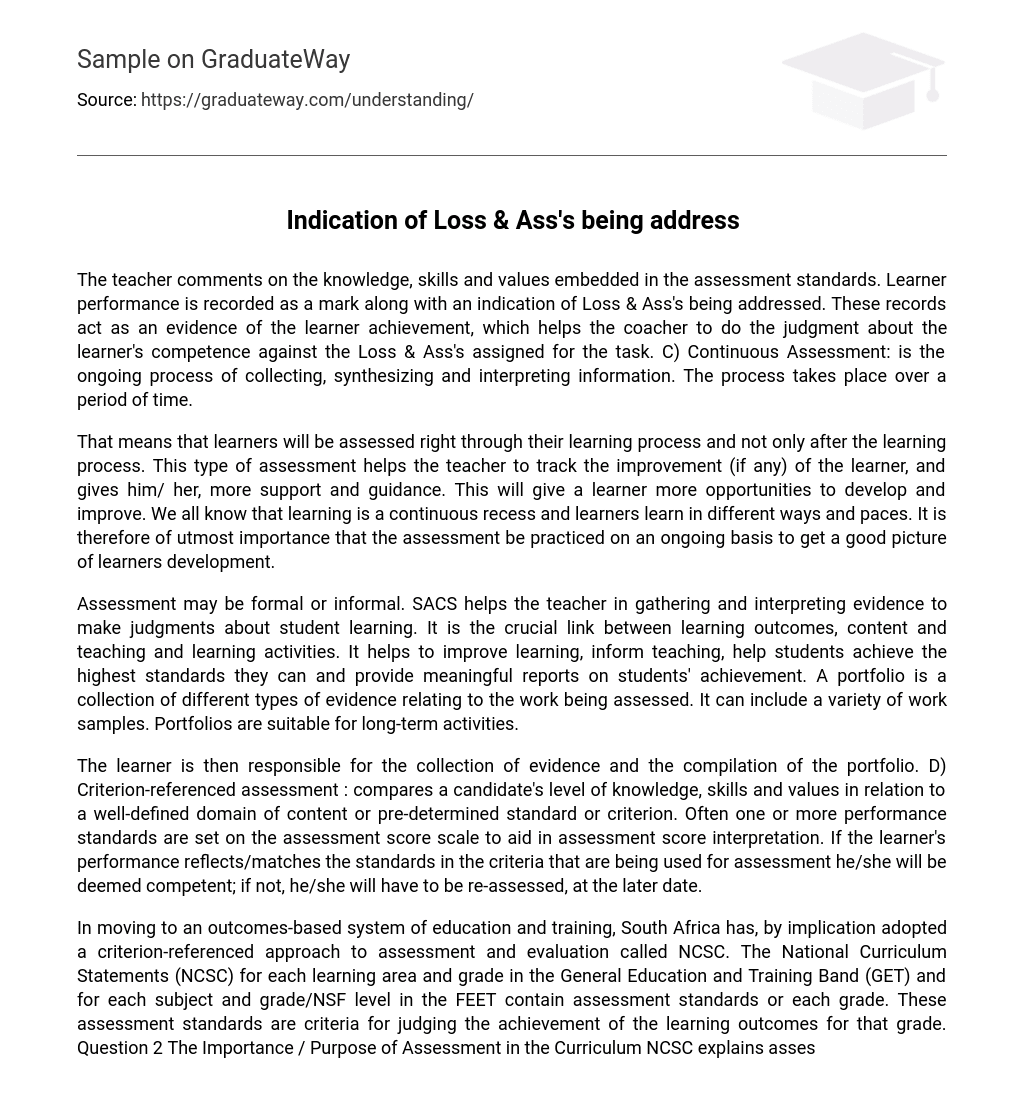The teacher comments on the knowledge, skills and values embedded in the assessment standards. Learner performance is recorded as a mark along with an indication of Loss & Ass’s being addressed. These records act as an evidence of the learner achievement, which helps the coacher to do the judgment about the learner’s competence against the Loss & Ass’s assigned for the task. C) Continuous Assessment: is the ongoing process of collecting, synthesizing and interpreting information. The process takes place over a period of time.
That means that learners will be assessed right through their learning process and not only after the learning process. This type of assessment helps the teacher to track the improvement (if any) of the learner, and gives him/ her, more support and guidance. This will give a learner more opportunities to develop and improve. We all know that learning is a continuous recess and learners learn in different ways and paces. It is therefore of utmost importance that the assessment be practiced on an ongoing basis to get a good picture of learners development.
Assessment may be formal or informal. SACS helps the teacher in gathering and interpreting evidence to make judgments about student learning. It is the crucial link between learning outcomes, content and teaching and learning activities. It helps to improve learning, inform teaching, help students achieve the highest standards they can and provide meaningful reports on students’ achievement. A portfolio is a collection of different types of evidence relating to the work being assessed. It can include a variety of work samples. Portfolios are suitable for long-term activities.
The learner is then responsible for the collection of evidence and the compilation of the portfolio. D) Criterion-referenced assessment : compares a candidate’s level of knowledge, skills and values in relation to a well-defined domain of content or pre-determined standard or criterion. Often one or more performance standards are set on the assessment score scale to aid in assessment score interpretation. If the learner’s performance reflects/matches the standards in the criteria that are being used for assessment he/she will be deemed competent; if not, he/she will have to be re-assessed, at the later date.
In moving to an outcomes-based system of education and training, South Africa has, by implication adopted a criterion-referenced approach to assessment and evaluation called NCSC. The National Curriculum Statements (NCSC) for each learning area and grade in the General Education and Training Band (GET) and for each subject and grade/NSF level in the FEET contain assessment standards or each grade. These assessment standards are criteria for judging the achievement of the learning outcomes for that grade. Question 2 The Importance / Purpose of Assessment in the Curriculum NCSC explains assessment as “an integral part of teaching and learning” and further explains that it should be included at all levels of planning. As a teaching and learning tool, assessment is a process through which instructors gather data about their teaching and their students’ learning (Hanna,2004). It is part and parcel of learning process. Teachers cannot be sure of the learning effectiveness ND that the goals of teaching & learning are achieved without assessment.
The assessment is done in order to evaluate the outcomes and then make decision or judgment about teaching / learning process or activities. It is the engine through which educators ensure that the proper data is transferred to the learner through teaching. Teaching is the transferring of data from source to the learner. The data provide a picture of a range of activities using different forms of assessment e. G. Pre-tests, observations, and examinations. Once data are gathered, one can then evaluate the student’s performance. There are a number of reasons why educators assess students and students assess themselves.
It is dependent on the goals perceived. There is assessment for education and assessment to education. Forms of assessment can be mainly classified into: Baseline; Formative; summarize; Diagnostic & Continuous assessment. These forms of assessments work hand in hand to provide a feedback; motivation; learning opportunities; preparation; teaching and learning etc. They work for both learners and the educators and can be summarized as follows: For learners: Diagnostic – to enable students to find out their level of competency/ knowledge/understanding at the beginning of a course.
C] Feedback – for students to ascertain their progress in relation to the learning outcomes of a course. CLC Learning opportunities – to provide students with the opportunities to develop their mastery of ideas or/and practice skills and competencies through articulating them in writing/oral work or other forms of expression. D Self-evaluation – to encourage students to make judgments about the quality of their own work. CLC Motivation – assessment tasks can enhance student motivation by providing frameworks for developing, reviewing r extending their understanding (for example, in a piece of research or a collaborative investigation).
For some students a series of manageable deadlines can also help them to keep engaged with the subject. 0 Preparation for longer term learning -formative assessment . For teachers: Diagnostic- teachers use assessment tasks to ascertain what students bring into a course so as to make the teaching and learning responsive to students” needs and build on existing knowledge Feedback – teachers gain feedback on students’ learning, detect misunderstandings, assess the effectiveness of their teaching and make appropriate modifications and adaptations.
Teaching and learning – teachers use assessment tasks as teaching and learning tools both through the nature of the tasks themselves and through formative feedback. Promoting self-evaluation – teachers give feedback which encourages students to make judgments about the quality of their own work and prepare them for future participation in the workforce. With the above-said it is clear that assessment is the key tool in teaching and learning and NCSC is more than correct if they describe assessment as “an integral part of teaching and learning”.





